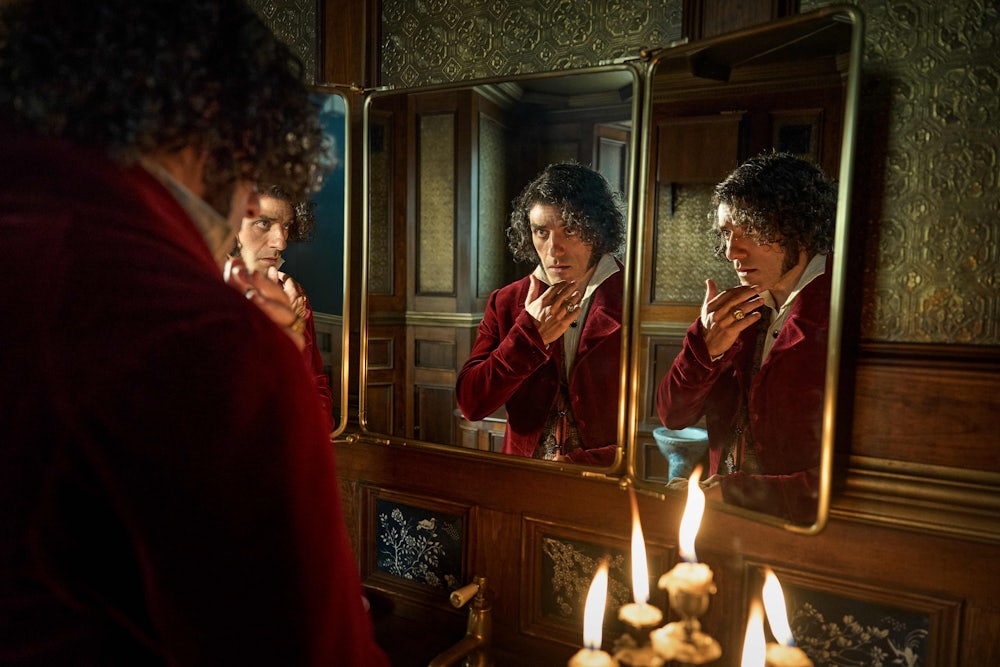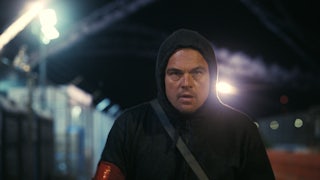The Creature abides. Mary Shelley’s seminal Modern Gothic was published in 1818: a sci-fi gloss on Paradise Lost seasoned with the gore of several European wars. The first movie version came in 1910, five years before The Birth of a Nation suggested the powers of writing history in lightning. It was early enough in the medium’s history, in fact, that J. Searle Dawley’s 16-minute, single-reel version of Frankenstein is itself something of a monster. The methodical process by which the eponymous mad scientist (played by Augustus Phillips) turns a blazing cauldron’s worth of corpses into a single, sentient being represented state-of-the-art silent-era spectacle; it also suggested something of the then-nascent craft of film editing, the suturing together of self-contained shots and scenes into a larger narrative.
Reviewers at the time aligned with the tale’s vengeful townsfolk, perceiving little more in the film than reckless abomination. “With all due deference to these distinguished producers,” wrote W. Stephen Bush in Moving Picture World, “such films as ‘Frankenstein’ ... while delightful literature to coroners, undertakers, gravediggers, and morgue-keepers, fail to please the general public.”
It’s fun to wonder whether Bush—or any of the other moralists determined to “eliminate all actual repulsive situations” from Shelley’s tale—were among the punters lining up 20 years later for James Whale’s sublime Universal Studios version of Frankenstein—a movie that not only pleased the general public but fixed the image of poor, flat-topped Boris Karloff, shuffling stoically through the Bavarian Alps (actually Malibou Lake, California), in the pop-cultural subconscious for all time. The Creature—billed as “?” in the opening credits—changed the world; he was tender and terrifying, not a predatory aristocrat like Bela Lugosi’s Count Dracula but a lumpenproletarian golem, the people’s champ. All the poor brute ever wanted was a friend. So what if a little girl accidentally got drowned in the process?
“I’d like to salute the monster, who really is the best friend I ever had,” said Karloff in 1965. When breaking down the dozens of screen adaptations of Frankenstein made in the decades since—sequels and spin-offs, gross-outs and kiddie flicks, satire and soft-core porn, Doctors Fronkenshteeen and Frank N. Further—the prevailing common denominator between them is a sense of respect for Whale’s eerie, surpassingly humane take. The most lyrical homage came via Spanish director Victor Erice’s 1973 masterpiece The Spirit of the Beehive, in which a mobile cinema brings Whale’s Frankenstein to a hamlet on the Castilian plateau under the control of Francoist forces. The film’s protagonist is a young girl who conflates the wounded Republican soldier hiding in a local barn with her memories of Karloff; she resolves to protect him from the authorities. The child’s-eye perspective of Erice’s masterpiece confers grace on the Monster while reconfiguring him, however abstractly, as a symbol of political resistance.
The Spirit of the Beehive is a favorite film of Guillermo del Toro, who drew directly on its setting and subtext for his widely acclaimed 1940s period piece Pan’s Labyrinth (2006). Del Toro is what you might call a blank-check director these days, having parlayed the success of Pan’s Labyrinth and The Shape of Water into a series of dream projects, including a (lovely) stop-motion version of Pinocchio and a deluxe, Netflix-subsidized version of Frankenstein. “They’re kind of the same myth,” del Toro told a recent interviewer; “I’ve always said, ‘I’m going to shoot Pinocchio like Frankenstein and Frankenstein like Pinocchio.’” It’s a good quote, and it accounts for the casting in the latter of Jacob Elordi as the Creature. Whatever else one can say about the slender, airbrushed Australian, he is a Real (It) Boy, and probably a limit case for taking a character defined by insecurity over his appearance and turning him into a sex symbol.
Certainly, Elordi’s trussed-up, tied-down position as the Creature seething in the basement of Victor Frankenstein’s estate carries more than just a hint of kink. He’s a fetish object: the Modern Prometheus as a hapless gimp. No wonder Victor’s sister-in-law-to-be Elizabeth (Mia Goth) is so determined to visit the family dungeon, gazing at its bound inhabitant through eyes widened by fear and desire. Victor (Oscar Isaac), meanwhile, is less than proud of his achievement in raising the dead; instead of sharing his work with the world, he’s hidden the Creature away, disgusted that the flesh-and-blood monument he’s erected to his own genius can’t articulate anything more than its maker’s name.
The ensuing subterranean battle of wills between the Doctor and the Creature is grimly funny, with Elordi’s endless repetition of “Victor” in a low, uncomprehending growl mocking the addressee’s recognition of his own defeat (they could be an ancient comedy duo—a dynamic Mel Brooks developed indelibly in Young Frankenstein). Unable to connect or converse with his illegitimate son and stranded on the far side of his own daddy issues, Dr. Frankenstein decides—petulantly, and with no small amount of self-hatred—to immolate the prisoner, a fiery mid-film set piece that sets up a perspective shift indebted to Shelley even as it tweaks her structure subtly.
The Creature serves in the first half of Frankenstein as a symbol of Victor’s hubris: the subject of a seemingly tall tale being spun by his creator as he convalesces onboard a massive boat that’s gotten frozen solid at the North Pole. In part two, he takes center stage as a protagonist, narrating his experiences after surviving his trial by (literal) fire, including his education at the side of a blind hermit who perceives and nurtures his student’s essential goodness. In the book, the Creature’s story is recounted by Victor; here he climbs aboard the boat and speaks directly to Victor and the ship’s captain, who’s already lost several men trying to keep the indestructible intruder at bay and decides he’d better sit down and listen up.
This is all more or less familiar ground, and del Toro treads it as magisterially as $120 million will allow. It almost goes without saying that Frankenstein is lavish and meticulous; del Toro’s brand as a connoisseur of period-specific bric-a-brac remains unchallenged. As to whether he’s actually shot Frankenstein like Pinocchio, it’s hard to say, because at this point in his career, del Toro shoots everything pretty much the same way—with a steady, grandiloquent classicism that suits his literal-minded approach to narrative and only rarely crosses over into genuine beauty or awe. For a director who frequently proselytizes on behalf of practical makeup and special effects and likes to rail against AI—which he recently called an “insult to life itself”—del Toro is willing to go spelunking in the uncanny valley; the overaggressive use of digital VFX in certain passages undermines the gobsmacking tactility of the costumes and production design. There are arresting images here, like the silhouette of the Creature as he stalks the ice floes or the crimson death mask of Victor’s mother during a funeral parade. But there are also plenty of stodgy, airless exchanges that a less reverent filmmaker would have either compressed or revised.
It’s not enough to say that the culprit is fidelity: not when del Toro’s take on the material sanctifies the Creature so that there’s a minimum of (human) blood on his hands. In the novel, the killing of Victor’s younger brother William—strangled in the woods by the Creature after carelessly letting slip his own surname—is played as a moment of irrevocable transgression; that Whale’s film softened the plot point by presenting the child as a stranger and keeping her death off-screen is understandable. But del Toro—whose much-vaunted humanism has always belied a sadistic streak when it comes to violence—proves too timorous here; it’s as if he doesn’t think he can make the (obvious) point that Victor is the story’s real monster unless the Creature occupies the moral high ground. He certainly doesn’t have the guts (as Kenneth Branagh did in his plummy 1996 version) to have the Creature murder Elizabeth, who instead dies accidentally at Victor’s hand. The effect should be devastating, but instead it’s weirdly sterile; the blood on Isaac’s hands may not actually be CGI, but it feels like it.
By off-loading (almost) all of the violence in the story onto Victor, including the slapstick-style smushing of a wealthy patron and arms dealer played by Christoph Waltz (who cashes his check with a palpable sense of his own superfluousness), del Toro may be trying to literalize one of Shelley’s greatest lines: the Doctor’s realization that “in seeking life, I created death.” The most interesting thing about the movie thus becomes the director’s contempt for his ostensible surrogate, manifested in Isaac’s sweaty, vainglorious, anti-leading-man acting. And yet even this tone rings hollow by the end, where del Toro allows the Creature to confer quiet absolution on his creator, as opposed to mourning him posthumously, as per Shelley. The part of del Toro that can’t help romanticizing (and sentimentalizing) his monsters accounts for the banally inspirational coda, in which Elordi uses his bulk to help free the stalled ship from the ice: a good deed that juxtaposes the crew’s joyous homeward bearing with his lonely solo journey.
Such uplift is arguably unbecoming, but it’s also part of del Toro’s brand of mythmaking, which cribs equally from the Necromicon and the Silver Linings Playbook. That his Frankenstein is a soulful patchwork like its protagonist is fair enough; that it’s somehow obsessive and dispensable at the same time is a paradox exacerbated by the prestige-streaming ecosystem that made it possible in the first place. In seeking his masterpiece, del Toro has created content.






